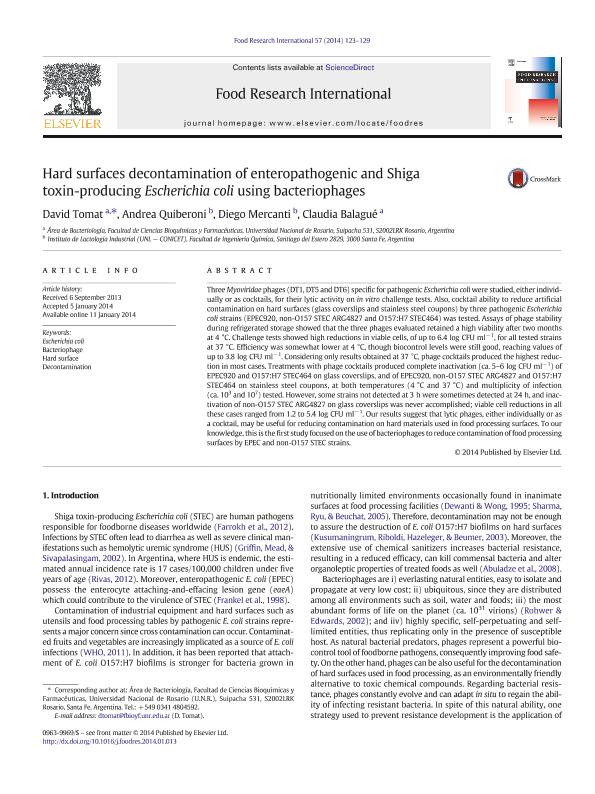Mostrar el registro sencillo del ítem
dc.contributor.author
Tomat, David Damian

dc.contributor.author
Quiberoni, Andrea del Lujan

dc.contributor.author
Mercanti, Diego Javier

dc.contributor.author
Balagué, Claudia
dc.date.available
2017-01-27T15:10:41Z
dc.date.issued
2014-03
dc.identifier.citation
Tomat, David Damian; Quiberoni, Andrea del Lujan; Mercanti, Diego Javier; Balagué, Claudia; Hard Surfaces Decontamination of Enteropathogenic and Shiga Toxin-Producing Escherichia coli using Bacteriophages; Elsevier; Food Research International; 57; 3-2014; 123-129
dc.identifier.issn
0963-9969
dc.identifier.uri
http://hdl.handle.net/11336/12069
dc.description.abstract
Three Myoviridae phages (DT1, DT5 and DT6) specific for pathogenic Escherichia coli were studied, either individually or as cocktails, for their lytic activity on in vitro challenge tests. Also, cocktail ability to reduce artificial contamination on hard surfaces (glass coverslips and stainless steel coupons) by three pathogenic Escherichia coli strains (EPEC920, non-O157 STEC ARG4827 and O157:H7 STEC464) was tested. Assays of phage stability during refrigerated storage showed that the three phages evaluated retained a high viability after two months at 4 °C. Challenge tests showed high reductions in viable cells, of up to 6.4 log CFU ml−1, for all tested strains at 37 °C. Efficiency was somewhat lower at 4 °C, though biocontrol levels were still good, reaching values of up to 3.8 log CFU ml−1. Considering only results obtained at 37 °C, phage cocktails produced the highest reduction in most cases. Treatments with phage cocktails produced complete inactivation (ca. 5?6 log CFU ml−1) of EPEC920 and O157:H7 STEC464 on glass coverslips, and of EPEC920, non-O157 STEC ARG4827 and O157:H7 STEC464 on stainless steel coupons, at both temperatures (4 °C and 37 °C) and multiplicity of infection (ca. 103 and 107) tested. However, some strains not detected at 3 h were sometimes detected at 24 h, and inactivation of non-O157 STEC ARG4827 on glass coverslips was never accomplished; viable cell reductions in all these cases ranged from 1.2 to 5.4 log CFU ml−1. Our results suggest that lytic phages, either individually or as a cocktail, may be useful for reducing contamination on hard materials used in food processing surfaces. To our knowledge, this is the first study focused on the use of bacteriophages to reduce contamination of food processing surfaces by EPEC and non-O157 STEC strains.
dc.format
application/pdf
dc.language.iso
eng
dc.publisher
Elsevier

dc.rights
info:eu-repo/semantics/openAccess
dc.rights.uri
https://creativecommons.org/licenses/by-nc-nd/2.5/ar/
dc.subject
Escherichia Coli
dc.subject
Bacteriophage
dc.subject
Hard Surface
dc.subject
Decontamination
dc.subject.classification
Alimentos y Bebidas

dc.subject.classification
Otras Ingenierías y Tecnologías

dc.subject.classification
INGENIERÍAS Y TECNOLOGÍAS

dc.title
Hard Surfaces Decontamination of Enteropathogenic and Shiga Toxin-Producing Escherichia coli using Bacteriophages
dc.type
info:eu-repo/semantics/article
dc.type
info:ar-repo/semantics/artículo
dc.type
info:eu-repo/semantics/publishedVersion
dc.date.updated
2016-11-23T20:14:06Z
dc.journal.volume
57
dc.journal.pagination
123-129
dc.journal.pais
Países Bajos

dc.journal.ciudad
Amsterdam
dc.description.fil
Fil: Tomat, David Damian. Universidad Nacional de Rosario. Facultad de Cs.bioquimicas y Farmaceuticas. Departamento de Microbiologia; Argentina
dc.description.fil
Fil: Quiberoni, Andrea del Lujan. Consejo Nacional de Investigaciones Científicas y Técnicas. Centro Científico Tecnológico Santa Fe. Instituto de Lactologia Industrial; Argentina. Universidad Nacional del Litoral; Argentina
dc.description.fil
Fil: Mercanti, Diego Javier. Consejo Nacional de Investigaciones Científicas y Técnicas. Centro Científico Tecnológico Santa Fe. Instituto de Lactologia Industrial; Argentina. Universidad Nacional del Litoral; Argentina
dc.description.fil
Fil: Balagué, Claudia. Universidad Nacional de Rosario. Facultad de Cs.bioquimicas y Farmaceuticas. Departamento de Microbiologia; Argentina
dc.journal.title
Food Research International

dc.relation.alternativeid
info:eu-repo/semantics/altIdentifier/doi/http://dx.doi.org/10.1016/j.foodres.2014.01.013
dc.relation.alternativeid
info:eu-repo/semantics/altIdentifier/url/http://www.sciencedirect.com/science/article/pii/S0963996914000179
Archivos asociados
